Syria makes steady progress in prevention and response to sexual misconduct
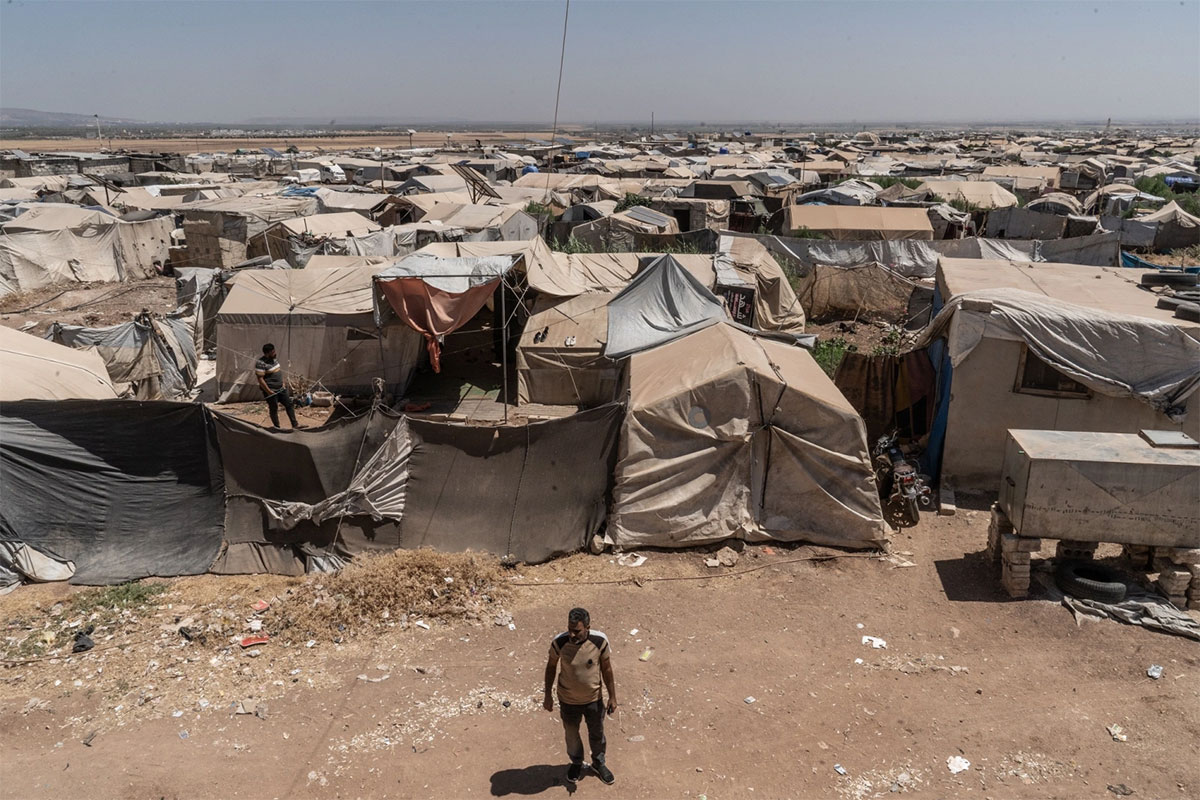 Widespread displacement in Syria continues to place girls and women at risk of violence and exploitation29 July 2024 – Syria’s 2023 earthquake put to the test the trainings on gender-based violence and mental health support that WHO has funded and organized in the country since 2018. The earthquake also prompted WHO to initiate its work on prevention and response to sexual misconduct (PRS). Under WHO’s definition, sexual misconduct includes sexual harassment, exploitation and abuse.
Widespread displacement in Syria continues to place girls and women at risk of violence and exploitation29 July 2024 – Syria’s 2023 earthquake put to the test the trainings on gender-based violence and mental health support that WHO has funded and organized in the country since 2018. The earthquake also prompted WHO to initiate its work on prevention and response to sexual misconduct (PRS). Under WHO’s definition, sexual misconduct includes sexual harassment, exploitation and abuse.
The 7.8-magnitude earthquake that struck Syria on 6 February 2023 brought death, destruction and displacement in its wake. Hundreds of thousands of people lost their homes and were forced to move to temporary shelters.
“When I arrived at the shelter where I was working, I was dismayed at the conditions people were facing. The shelter was overcrowded and had no separators. There was just one toilet for 1000 people,” recalls Dr Hala Zghaibeh, National Professional Officer and PRS focal point in the WHO Country Office in Syria. “These difficult conditions placed girls and women at risk of violence and exploitation.”
WHO Syria drew on its partnership with the Syrian Commission for Family Affairs and Population (SCFAP) to address the risk of sexual misconduct among people affected by the earthquake. WHO also initiated a new partnership to operationalize PRS activities following the disaster.
SCFAP is the only national government agency to handle social protection and it also runs the national victim and survivor support unit. Following the earthquake, SCFAP sent 150 frontline support workers – trained with funds from WHO – to places where there was a high risk of gender-based violence, to offer support and referral services to people in need.
Foundational work on prevention and response to sexual misconduct
In 2018, WHO launched trainings in Syria on tackling gender-based violence, first in Aleppo and later in 9 more governorates. Organized with the Ministry of Health, nongovernmental organizations (NGOs) and United Nations health sector partners, these trainings first had to overcome the obstacle of how to broach such a sensitive subject.
Dr Wail Ismail, Public Health Officer and PRS focal point in WHO Syria, reflects on this earlier initiative: “Gender-based violence and sexual misconduct were sensitive topics and continue to be so in many parts of the world. As a workaround in our trainings, we used language that was familiar to public health and reproductive health care providers, when supporting survivors of violence, and began by enhancing their psychosocial support skills.”
Syria has come a long way since then, navigating taboos and scepticism to reach a place where senior Ministry of Health officials now serve as focal points for PRS. In the 5 years since the initial trainings, WHO Syria has made steady progress in preventing sexual misconduct, as well as gender-based violence, by reshaping institutional responses to these issues.
The power of partnerships
 At the Aleppo health centre, women and children learn about accessing support services for gender-based violencePartnerships have been instrumental in driving Syria’s progress in PRS. An example is WHO’s collaboration with the Institute of Human Resource Management (IHRM), an NGO that supports organizations to build capacity in developing policies against sexual misconduct. It also offers trainings on such policies and can help devise a related code of conduct, making workplaces safer spaces.
At the Aleppo health centre, women and children learn about accessing support services for gender-based violencePartnerships have been instrumental in driving Syria’s progress in PRS. An example is WHO’s collaboration with the Institute of Human Resource Management (IHRM), an NGO that supports organizations to build capacity in developing policies against sexual misconduct. It also offers trainings on such policies and can help devise a related code of conduct, making workplaces safer spaces.
Through a WHO-financed project, IHRM delivered training-of-trainers sessions on PRS to 38 people from 6 Syrian governorates over 8 months in the period 2023–2024. The training has been cascaded to 565 people, chiefly from NGOs but also from the public and private sectors, helping to foster a culture of accountability and support within workplaces.
Ministry of Health adopts PRS actions
Yet another notable success has been the Syrian Ministry of Health’s uptake of PRS actions since 2023. More than 1700 public health personnel from across the country have been trained on the topic.
Dialogues and sessions with programme directors at the Ministry of Health have helped strengthen support for PRS work. The Ministry is gradually incorporating PRS as part of its strategic planning and priority setting, with ministerial focal points for PRS appointed at a high level, including the Deputy Minister for Health Affairs. A workshop held in May 2024, on development of policy and institutional capacity-building, was attended by 35 people, including the deputy ministers of health and justice.
Dr Razan Tarabishi, Director of Primary Health Care at the Ministry of Health, has been a steadfast champion of the adoption of PRS policies and actions within the Ministry. “WHO presented us with a significant opportunity to familiarize ourselves with PRS policies,” she explains. “We can now better understand the discussions on the topic at the World Health Assembly and are able to brief and support our Minister better. This is valuable knowledge for continued efforts in our country.”
Syria’s progress is reflected not only in the numbers of people trained and policies drafted in workplaces, but also in the palpable shift in attitudes. What was once taboo is now openly addressed, paving the way for survivors of sexual misconduct to seek support without fear or stigma. Through sustained advocacy and engagement, institutional barriers are coming down and PRS in Syria is now a shared responsibility.
What next?
WHO Syria will continue to strengthen its partnerships and engagement with the Ministry of Health and other government counterparts, in particular to develop stronger PRS policies and explore potential legal amendments.
WHO Syria is also working to deepen and scale up the capacities of NGOs and the public and private sectors in PRS and in strengthening assistance for survivors.
The Big Catch-Up: Syria rolls out initiative to reach millions of children missed during COVID-19 pandemic
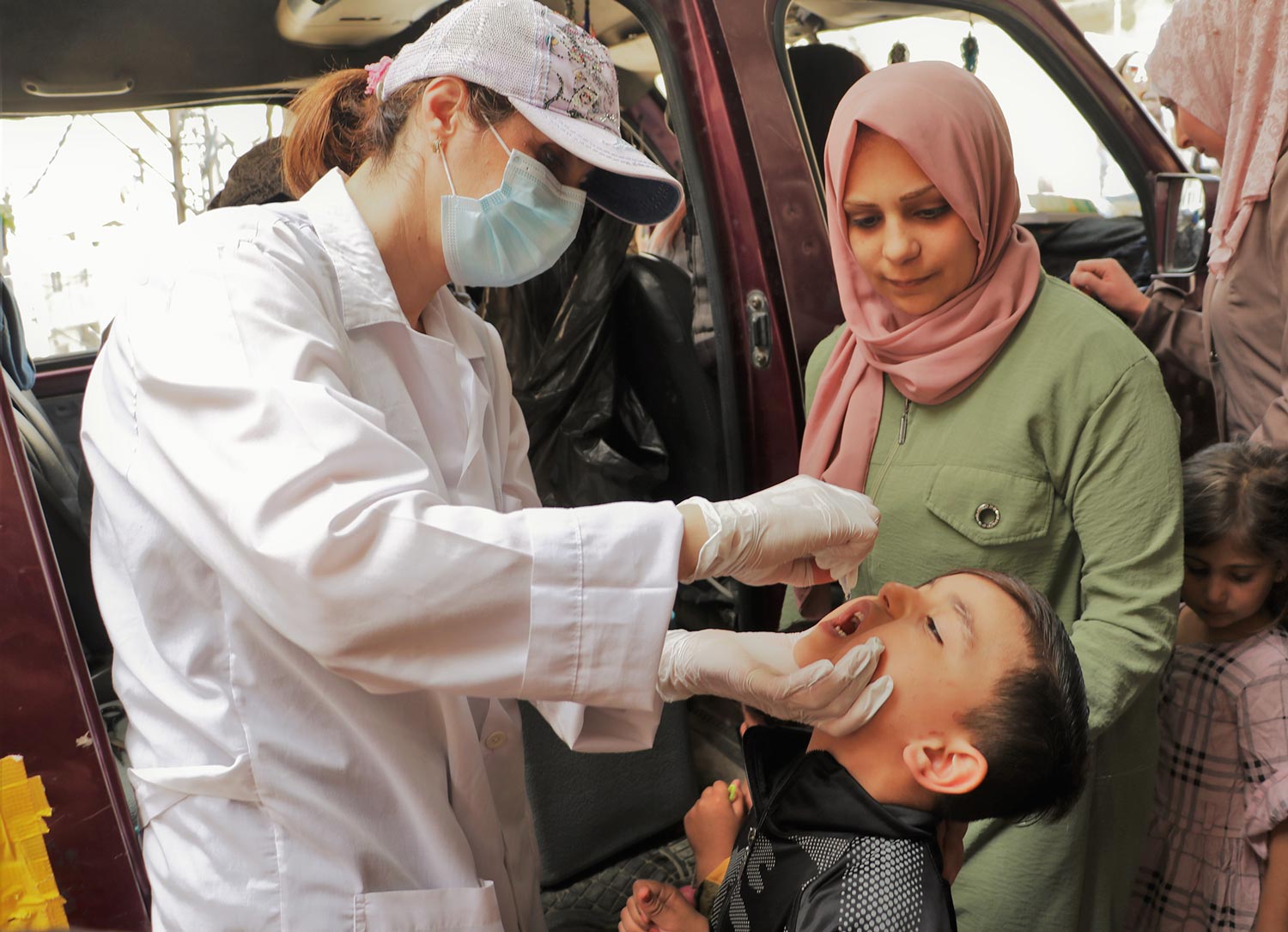 Immunization activity in Rural Damascus, Syria, 2024. Photo credit: WHO Syria23 July 2024, Damascus – The Syrian Ministry of Health (MOH), supported by WHO, UNICEF, and Gavi, the Vaccine Alliance, has launched the second round of Big Catch-Up vaccination activity this week.
Immunization activity in Rural Damascus, Syria, 2024. Photo credit: WHO Syria23 July 2024, Damascus – The Syrian Ministry of Health (MOH), supported by WHO, UNICEF, and Gavi, the Vaccine Alliance, has launched the second round of Big Catch-Up vaccination activity this week.
The Big Catch-Up is an initiative launched by global health partners in April 2023 to address the decline in childhood vaccination rates observed during the COVID-19 pandemic as a result of overburdened health systems and disrupted access to medical care. This is the second phase in Syria, following an initial phase in April this year.
During this round, about 2 million children under the age of five are targeted to be screened, and more than 300,000 are expected to be vaccinated with different childhood vaccines. The activity aims to reach children through fixed sites and mobile vaccination teams across the selected areas of coverage, with over 7,500 health workers deployed. In addition, a measles campaign will be conducted in 68 districts identified as priority districts for measles, where children will receive measles rubella / measles mumps rubella (MR/MMR) vaccines regardless of their vaccination status.
To ensure vaccine uptake, MOH Syria and partners are also rolling out proactive community engagement activities to promote vaccination of children, including through partnership with community leaders, social and mass media, as well as other influencers.
“The Big Catch-Up initiative in Syria is not only an opportunity to immunize and protect all children up to 5 years old, including zero dose children, but is also aimed at strengthening routine immunization from planning, service delivery and to monitoring systems. Gavi and our partners are committed to continuing supporting the Ministry of Health towards a strong and resilient immunization national programme, which is the essential pillar for combating disease outbreaks,” said Véronique Maeva Fages, the Senior Country Manager for Syria at Gavi.
“The Big Catch-Up initiative is a vital step in overcoming the setbacks caused by the COVID-19 pandemic and building a stronger, more resilient health system. UNICEF remains committed to supporting the Syrian Ministry of Health and our partners in this critical effort to safeguard the future of children in Syria," said Yasumasa Kimura, UNICEF Representative in Syria.
Dr Iman Shankiti, acting WHO Representative to Syria, echoed and emphasized the importance of these efforts: “Our commitment to the Syrian people is unwavering, and we stand together with our health partners to strengthen the immunization programme as a cornerstone of achieving universal health coverage”.
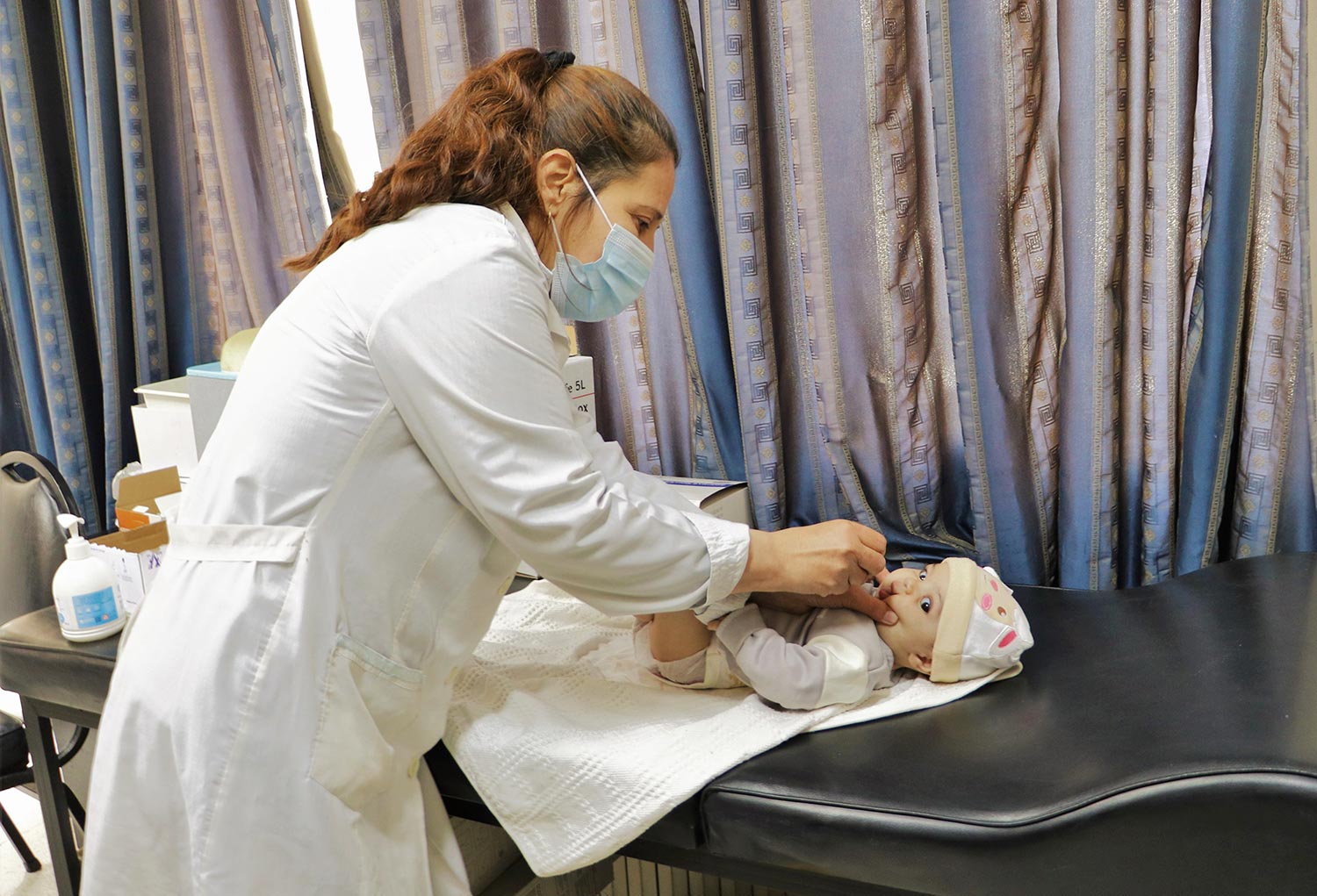 Immunization activity in Rural Damascus, Syria, 2024. Photo credit: WHO SyriaThrough global catch-up efforts supported by GAVI and other donors, partners aim to help lower-income countries close immunization gaps, restore immunization coverage to pre-pandemic levels, and strengthen immunization systems in the longer term.
Immunization activity in Rural Damascus, Syria, 2024. Photo credit: WHO SyriaThrough global catch-up efforts supported by GAVI and other donors, partners aim to help lower-income countries close immunization gaps, restore immunization coverage to pre-pandemic levels, and strengthen immunization systems in the longer term.
In Syria, the first round managed to screen the vaccination status of more than 1.8 million children and vaccinated zero-dose and unvaccinated children with the needed vaccines. Additionally, 1.8 million received the Polio vaccine (bOPV) and 1 million received Vitamin A regardless of their vaccination status.
The second round of the Big Catch Up activity coincides with a joint high-level mission by WHO, UNICEF, and Gavi, the Vaccine Alliance, to Syria. The mission is aimed at understanding the status of the current immunization programme and continuing dialogue on longer-term sustainable solutions in vaccine procurement and financing.
The next round of the Big Catch-Up initiative is slated for October this year.
About WHO
The World Health Organization works with 194 Member States across six regions and from more than 150 offices to provide global leadership in public health, promote health, keep the world safe, and serve the vulnerable. Our goal for 2019-2023 is to ensure that a billion more people have universal health coverage, to protect a billion more people from health emergencies, and provide a further billion people with better health and wellbeing. For more information about WHO and its health agenda, visit www.who.int.
About UNICEF
UNICEF promotes the rights and wellbeing of every child, in everything we do. Together with our partners, we work in 190 countries and territories to translate that commitment into practical action, focusing special effort on reaching the most vulnerable and excluded children, to the benefit of all children, everywhere.
For more information about UNICEF and its work for children, visit www.unicef.org. Follow UNICEF on Twitter and Facebook.
About Gavi, the Vaccine Alliance
Gavi, the Vaccine Alliance is a public-private partnership that helps vaccinate more than half the world’s children against some of the world’s deadliest diseases. The Vaccine Alliance brings together developing countries and donor governments, the World Health Organization, UNICEF, the World Bank, the vaccine industry, technical agencies, civil society, the Bill & Melinda Gates Foundation, and other private sector partners. View the full list of donor governments and other leading organizations that fund Gavi’s work here.
Since its inception in 2000, Gavi has helped to immunize a whole generation – over 1 billion children – and prevented more than 17.3 million future deaths, helping to halve child mortality in 78 lower-income countries. Gavi also plays a key role in improving global health security by supporting health systems as well as funding global stockpiles for Ebola, cholera, meningococcal, and yellow fever vaccines. After two decades of progress, Gavi is now focused on protecting the next generation, above all the zero-dose children who have not received even a single vaccine shot. The Vaccine Alliance employs innovative finance and the latest technology – from drones to biometrics – to save lives, prevent outbreaks before they can spread, and help countries on the road to self-sufficiency. Learn more at www.gavi.org and connect with us on Facebook and X (Twitter).
Media contacts:
Gavi: Collins Mwai
UNICEF: Gulyalek Soltanova
WHO: Tania Seburyamo,
Maya’s inspiring journey of hope, strength and overcoming childhood cancer
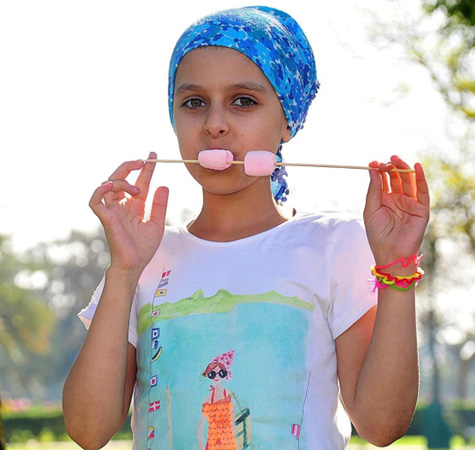 Maya in 2012. She was 10 years old when she started cancer treatment. Photo credit: BASMA23 July 2024 – In Syria, childhood cancer is ranked third among the leading causes of death in the country. Damascus and its suburbs are the main areas where cancer treatment is offered, putting huge pressure on hospitals here to admit children from across Syria. Despite the ever-shrinking availability of cancer services across the country, a network of dedicated organizations and health workers continue to strive to provide life-saving care.
Maya in 2012. She was 10 years old when she started cancer treatment. Photo credit: BASMA23 July 2024 – In Syria, childhood cancer is ranked third among the leading causes of death in the country. Damascus and its suburbs are the main areas where cancer treatment is offered, putting huge pressure on hospitals here to admit children from across Syria. Despite the ever-shrinking availability of cancer services across the country, a network of dedicated organizations and health workers continue to strive to provide life-saving care.
Maya, a young cancer survivor, shares her story, which reflects her patience, strength and an unbreakable spirit of hope.
Maya’s story, in her own words
When I was just 10 years old, my brother and I were playing a game of wrestling in our home in As-Sweida, Syria. I felt a lump in my abdomen, but what seemed like normal stomach pain turned out to be something far more serious. The next day, a CT [computed tomography] scan revealed the shocking news: I had cancer. The diagnosis was abdominal sarcoma, specifically a desmoplastic small round cell tumour. This was July 2012, and the start of a challenging journey.
My mother and I went to Al-Biruni University Hospital in the Harasta suburbs outside of Damascus to begin my treatment. By chance, we found the BASMA association on one of the hospital floors where they treat children with cancer. My mother spoke with the doctors, and soon I was admitted into BASMA’s care to start my treatment.
To receive my chemotherapy doses, my mother and I had to travel each time from As-Sweida back to the hospital in Harasta. This journey was terrifying – the road was deadly, filled with bombings and snipers. But I had no choice, I couldn’t give up.
My treatment was complex. I had surgery for my chemotherapy to be given through a port because my arteries had hardened. The pain of each dose was immense, like a fire burning inside me. Isolation became my new reality as my immune system weakened, and I was cut off from the world and school. Every time I visited the hospital, I would see other children battling their own challenges. I often wondered why I had survived and what purpose my life now held.
The year 2015 marked one of the most beautiful moments of my life – 3 years after this journey began, I learned I was in remission. My condition improved.
There was, however, a heavy cost. Because of the cancer treatment, I can never be a mother. This reality is painful, but I have decided to remain strong.
Today, at 24 years old, I look back on that time with gratitude. I graduated from the faculty of business administration with a score of 99% and I am now in my second year of studying media. My ambitions are boundless. I speak at TEDx, volunteer with BASMA and the Syrian Arab Red Crescent, and cherish my Syrian heritage.
WHO’s ongoing support to BASMA
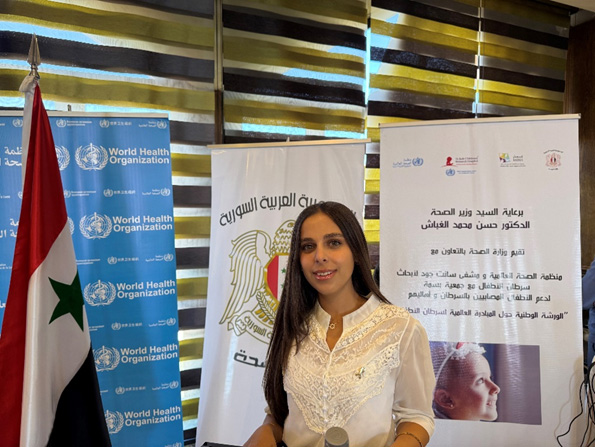 Maya in 2024. With her cancer in remission since 2015, her ambitions are boundless. Photo credit: WHO/WHO SyriaIn 2024, WHO’s support to BASMA aims to provide comprehensive care for children with cancer, like Maya, and encompasses both medical and psychosocial aspects. The initiative emphasizes the importance of holistic support: the social, psychological, spiritual and functional dimensions are crucial during the treatment process, and upon recovery, while patients face a gradual return to daily life.
Maya in 2024. With her cancer in remission since 2015, her ambitions are boundless. Photo credit: WHO/WHO SyriaIn 2024, WHO’s support to BASMA aims to provide comprehensive care for children with cancer, like Maya, and encompasses both medical and psychosocial aspects. The initiative emphasizes the importance of holistic support: the social, psychological, spiritual and functional dimensions are crucial during the treatment process, and upon recovery, while patients face a gradual return to daily life.
In the past 5 years, with generous donations from Japan and Kuwait, WHO has provided BASMA with advanced diagnostic medical equipment to enhance cancer treatment. This support includes 2 polymerase chain reaction (PCR) machines and 2 safety cabinets, 30 chemotherapy beds, anaesthesia machines, a spectrophotometer for chemistry tests, a haematology analyser, and a flow cytometer for treatment follow-up.
These contributions have significantly strengthened BASMA’s capacity, enabling the association to double the number of children it is able to admit annually.
WHO and BASMA are working to scale up this initiative over the years to come, to ensure that all children with cancer in Syria can access life-saving care, wherever they live.
WHO and Japan transform Al-Qamishli National Hospital in north-east Syria amid growing health crisis
 A beneficiary of the project receives health services at Al-Qamishli National Hospital. Photo credit: WHO/WHO Syria
A beneficiary of the project receives health services at Al-Qamishli National Hospital. Photo credit: WHO/WHO Syria
16 July 2024, Syria – WHO proudly announces the official handover of key units in Al- Qamishli National Hospital, north-east Syria, to the Ministry of Health. This follows their rehabilitation as part of the Project for Strengthening Health Care Services. This initiative, supported by the people of Japan, aims to improve the resilience and sustainability of health facilities in Syria.
During the one-year rehabilitation project, the main focus was to rehabilitate the burns care, intensive care, emergency, dialysis, and medical imaging units of Al-Qamishli National Hospital. Outdated medical equipment was also upgraded to better serve the community.
Amid a deepening health crisis in the region, the reopening of the units marks an important milestone in delivering essential medical assistance to the community. Local people have been increasingly affected by the ongoing crisis and the lack of access to health care.
Al-Qamishli National Hospital is one of 16 public hospitals in north-east Syria, most of which are either partially functional or out of service. The two-storey complex has a 200-bed capacity and functions as the main referral hospital in the area. Overburdened since the start of the crisis in Syria, it required major rehabilitation. Prior to the project, the hospital served an estimated 200 000 patients a year. This number is expected to increase following the improvements.
As Dr Iman Shankiti, WHO Representative to Syria, thanked the people of Japan for their partnership and highlighted the project’s broader impact on north-east Syria’s health system: “This project represents a major achievement in our ongoing efforts to improve access to advanced medical care services, particularly in underserved areas. We will be able to provide better health services and improve the lives of thousands in north-east Syria.”
Mr Adam Abdelmoula, United Nations Resident Coordinator and Humanitarian Coordinator for Syria, echoed her sentiments and added, “It is imperative that the services in this hospital are made accessible to all people living in Al-Hassakeh governorate and the surrounding areas.”
The relaunch of Al-Qamishli National Hospital comes at a critical time. The health system in north-east Syria must contend with significant challenges, including instability, leading to shortages of medical supplies, health workers and functional infrastructure.
Through the project, various items of medical equipment were procured and distributed to the hospital to improve its diagnostic capabilities. This equipment includes a computed tomography (CT) scanner, magnetic resonance imaging (MRI) machine, colour Doppler ultrasound scanner cardiac diagnostic machine, C-arm machine, X-ray unit for the operating theatre and a mobile digital radiographic X-ray unit.
Further, the fully renovated dialysis unit now features 6 new dialysis machines and a water treatment station. Moreover, the hospital’s 3 laboratories – for the emergency department and outpatient clinics, and the central laboratory – have received new equipment to enhance diagnostic services.


